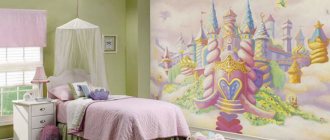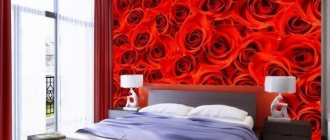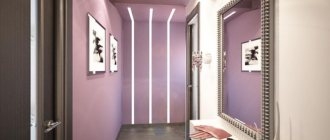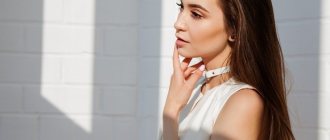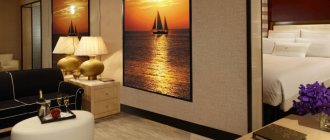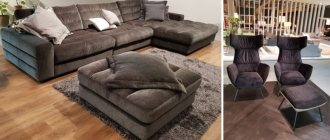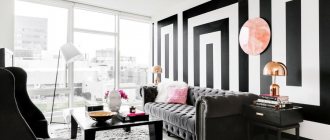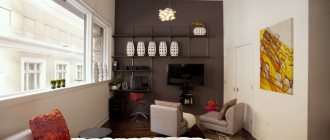Ceramic tiles have been and remain the most popular material for finishing bathrooms. However, it is not at all necessary to seal the entire toilet or the entire bathroom with tiles. Tile is desirable where there is a high probability of contamination and exposure to moisture. In other areas, other types of finishing can be used.
The tiles go well with painting, plaster, wood paneling and, of course, wallpaper. By the way, combined finishing is very popular nowadays.
There is no need to be afraid of wallpaper in the toilet. They do not “cheapen” the interior at all, because this solution is classic and elegant. Of course, if you paste wallpaper from floor to ceiling, such a finish most likely will not last long. And from a sanitary and hygienic point of view, this option is undesirable, especially if this is not a guest bathroom, but the main toilet for the whole family. But if you combine wallpaper with tiles , issues of hygiene and durability will lose their urgency.
Let's talk about the pros, cons and features of this solution, and be inspired by the examples in the photo.
Wallpaper in the toilet: advantages
1. Savings. Tiles tend to be more expensive than wallpaper. The cost of the work also varies: they charge much more for laying tiles than for gluing wallpaper. If you combine tiles with wallpaper , the repair will be significantly cheaper than in the case of total tiling.
2. Comfort. With wallpaper, the bathroom looks more homely, warmer and more comfortable. It does not resemble an operating room or some other not very pleasant room.
3. Visual effect. Combining tiles and wallpaper in a bathroom is usually done by horizontally dividing the walls into upper and lower levels. Wallpaper on top, tiles on bottom. This division visually reduces the height of the ceiling and increases the width of the room. As a result, the toilet does not look like a pipe.
4. Ease of implementation of “redesign”. If the bottom is tiled with laconic neutral tiles and wallpaper is pasted on top, changing the decor after a few years will not be difficult. All you need to do is re-paste the wallpaper and change the decor, accessories, and plumbing fixtures. With a minimum of effort and expense, it will be possible to radically change the appearance of the bathroom.
If the toilet is covered with tiles from floor to ceiling, changing the design becomes difficult and costly. The sight of the bathroom may tire you over time, but you have to endure it. True, there is still a way out - painting the tiles, for example. But this is also an intermediate, temporary option.
5. Stylistic component. Wallpaper is a wonderful assistant in the matter of “style formation”. The texture, color and pattern of wallpaper play an important role in shaping the overall picture and influence the perception of the interior. Well-chosen wallpaper helps express style and effectively emphasizes it.
We'll talk about which wallpaper to choose for a particular style below.
Additional finishing of toilet walls
In addition to wallpaper, additional decorative elements can be used to decorate the walls in the toilet room, such as borders and friezes, available in a wide variety of designs and colors. With their help, you can easily enliven the interior of a room and hide the transitions that arise when using several types of wallpaper.
Borders are indispensable for separating parts of the wall, each of which is decorated with different wallpaper. The frieze is fastened directly along the upper edge of the covering.
Wallpapering walls requires the correct choice of adhesive, which should be a substance that has antibacterial protection. The use of inappropriate glue creates an additional environment for the growth of bacteria, and this should not be allowed under any circumstances.
Wallpaper in the toilet: cons
1. Inadmissibility of wet and rough cleaning. Wallpaper, of course, can be wiped, but only with a dry or slightly damp cloth. Wet it thoroughly, use chemicals, scrub thoroughly - it won't work. Whatever one may say, wallpaper becomes dirty over time. With tiles, of course, it is much easier to maintain close to ideal cleanliness.
2. Risk of peeling and cracking. If there is high humidity in the toilet (and this happens often), the wallpaper may peel off and come off a little at the joints. In addition, they often crack in the corners, especially when it comes to new buildings. These nuances can spoil the appearance of the room and give it an unkempt appearance.
3. Bad forecast if neighbors flood. A toilet, all of whose wall surfaces are covered with tiles, will most likely not suffer anything (unless the ceiling is damaged). The wallpaper will probably be hopelessly damaged. You'll have to re-glue it.
Which wallpaper is best?
There are many types of wallpaper that are suitable for the toilet room. It is worth starting from individual preferences and characteristics of the bathroom.
Washable
Many people choose washable wallpaper, in other words, sheets of paper on which one or another design is applied. The surfaces of the material are protected with a waterproof film, thanks to which moisture will not cause them to peel off from the walls. This model has a low cost, and sticking it on the walls will not be difficult, which is a significant advantage. With a protective film, the wallpaper will not be afraid of dust, dirt, mold and mildew. This model has advantages over the usual paper one; it will last much longer.
With synthetic base
You can hang wallpaper that has a synthetic base. That is, they consist of textile fabrics glued to thin foam rubber. This finishing material has undoubted advantages: it is environmentally friendly and has good sound and heat insulation. Instead of wet cleaning, you need to clean this wallpaper with a vacuum cleaner.
Vinyl
Some people prefer vinyl wallpaper. They will not be cheap to repair, but this material is moisture resistant, so it will not be afraid of deformation from dampness and temperature changes. Gluing them is not difficult, you just need to take into account the special choice of glue that is suitable for heavy material. Vinyl wallpaper will not bubble or peel off the wall, its appearance will not change for a long time, it will serve for ten years or even longer.
Glass wallpaper
Another interesting option is glass wallpaper, which is made from fiberglass (paper and thin glass threads). The canvas itself is light gray, but then it is painted over with paint in different shades. These wallpapers are quite expensive, but they are worth it considering their characteristics. They are durable, so they will not wear off due to any damage for a long time (for this reason, they are used not only for bathrooms in apartments, but also for public toilets).
The fiberglass canvas will almost not absorb wet fumes, they are not afraid of chemicals and even aggressive substances (powders, solvents, etc.), so you can safely use a variety of detergents to clean them.
Fiberglass models have environmental and fire protection properties. Neither water nor fire will harm them. Another advantage is that this material can be painted in any color, which will allow you to turn interesting interior ideas into reality.
Decorating the interior of a room such as a toilet is a difficult task. What materials to choose for DIY repairs? Basically, the finishing (in the photo) is not wallpaper, since there is high air humidity in the toilet.
Wallpaper in the toilet: which one to choose and how to combine it with tiles?
As already mentioned, wallpaper actively participates in the formation of style. If a specific direction is chosen for the toilet, then the wallpaper should be selected accordingly.
So, for a bathroom in Provence or country style, wallpaper with a delicate flower pattern is ideal. The same samples would be appropriate in modern classics.
Wallpaper with a metallic pattern, as well as black-and-white and silver-gray pieces with ornaments, will fit perfectly into luxurious American classics and art deco.
Wallpaper with large green leaves is popular for bathrooms. They are very organic in the modern atmosphere, including the Scandinavian one. These wallpapers are also suitable for eco-friendly designs.
In general, the natural theme for toilets is now relevant. Living green walls are created in bathrooms, surfaces are decorated with moss, real wood cuts are used for countertops, etc. These details create the illusion of spaciousness and freshness in a small room. To maintain eco-themes, not only “green-leaf” wallpapers are suitable, but also samples made from natural materials (or imitation ones). We are talking about the so-called grasscloth wallpaper, that is, fibrous. They are expensive, but they last a long time. They are more resistant to moisture and cleaning than their paper counterparts.
If you don’t like the designs, ornaments, or textures, you should turn your attention to plain wallpaper without a pronounced texture or pattern. It will harmoniously fit into any style surroundings.
As for the combination method , the most common option is dividing the walls by height. There are tiles below, wallpaper on top. To what height should I lay the tiles? There is no single canon. You can do it in a way that is convenient for the owners.
It must be taken into account that the tiles perform not only an aesthetic, but also a protective function. Because, unlike wallpaper, it can be polished to a shine. It would be logical to cover with tiles the surface of the walls that may be subject to contamination and moisture.
In general, the classic height of the panels (and the tiles perform exactly this function when dividing walls) is up to the upper edge of the back of the chair. Of course, the height of chairs varies, but on average it is somewhere around 90-95 cm .
However, the height of the “tile panel” should also depend on the size of the tile, because it is very desirable to do without trimming. Here it is better to make a decision in the direction of increasing rather than decreasing the height. For example: if you are laying tiles 12 cm high, it is preferable to take 8 whole tiles (the cladding height will be 96 cm), rather than 7 and a half. If the height of the tile is 40 cm, it would be more correct to lay 3 rows of whole tiles (it will be 120 cm), and not 2 with a core.
If the toilet has a washbasin, you can raise the lining level higher by covering this wet area with a protective apron. But if the goal is to save on tiles, you can go the other way - make a common lining below the sink, and form a separate apron from tiles, mosaics, or glass near the washbasin.
Dividing walls by type of panel is not the only way to use wallpaper in the toilet. You can cover almost everything with tiles, and stick wallpaper as an accent, on any separate area - for example, above the toilet. Or cover 2-3 walls of the toilet completely with tiles, and cover one wall away from wet areas with wallpaper to its full height. In general, there is a lot to think about when planning a renovation.
Color solutions
Black
A bold color is more suitable as an additional color, for example, for partial wall decoration or as a pattern on wallpaper. A finish with abundant use of black will look impressive, but there is a chance that such an interior will quickly become boring.
White
The white tone is beautiful alone and in company with other colors. The main advantage of white is that it visually increases the space, a great way to decorate a small room. The finish can be combined with other, brighter colors. For example, decorate the wall behind the tank with white wallpaper with a pattern, and the rest with plain structural wallpaper.
Gray
Gray color is multifaceted, it can start from a light shade of white and end with a graphite tone. The finish with photo wallpaper, combination with other shades and different textures will look impressive.
Beige
A calm, classic shade is a good choice for both large rooms and a compact toilet. A beige wallpaper with a noticeable texture and a beautiful plain or colored pattern will look good. Beige is suitable for classic and modern design.
Rules for choosing wallpaper for the toilet
Have you decided to renovate your apartment? Don't know what materials to choose for your toilet? Let's try to find answers to these questions together. Let's start with the fact that finishing and repairing walls can be done using liquid wallpaper. These materials differ significantly from traditional rolled trellises. In terms of their external characteristics, they are identical to decorative plaster (in the photo - design using liquid materials).
In the initial state, liquid materials are a powder mixture. Let's consider the pros and cons of using such finishing materials when renovating rooms with high humidity. Liquid wallpaper “evens out” minor damage on the walls. But before starting repairs, we advise you to carry out preparatory work and carry out all the necessary work using special water-repellent primers. Manufacturers offer detailed instructions, following which you can prepare a complete liquid mixture. Design using these materials (example of a finished interior in the photo) allows you to obtain walls and ceilings with unique aesthetic characteristics.
How to choose?
In addition to the fact that the wallpaper must be applicable in a humid environment, there are a number of requirements that should be taken into account when choosing one option or another. To ensure a long-lasting renovation, only high-quality materials are purchased, which means not the cheapest ones.
In apartments, toilets are often very cramped. For a small room you need to choose wallpaper that visually enlarges the space. materials are better suited for this . Thanks to vertical and horizontal stripes, walls can be visually “increased” in height and width.
If there is a pattern on the coating, it should be small. Large images hide space in a limited area. Their use is permissible only where the toilet room is larger than usual.
Vinyl wallpapers
Why are they rarely used to decorate toilet walls? The reason for the lack of demand for these finishing materials is their high cost. There are no special problems when working with vinyl materials; you just need to purchase special glue for them, which is designed for heavy trellises. Given the large thickness of the material, when gluing the sheets, they are placed end-to-end, avoiding overlapping stripes.
The use of wallpaper for toilet walls can hardly be called exotic; it is only important to choose them correctly and take into account all the features of the room being renovated.
Application process and its subtleties
Pasting a toilet with liquid wallpaper is not difficult and not very expensive. For 6.5 squares of wall you will need only 1 kg of dry mixture and primer. If you add decorative filler, then even less composition will be required.
You just need to first inquire at a hardware store about whether the properties of the brand you are purchasing allow you to introduce foreign components into it, and purchase the appropriate variety.
Psychologists do not recommend pasting functional units with aggressive colors, but in the assortment of powder mixtures you can find almost any shade of the visible spectrum, so we glue the one that is more compatible with the plumbing and the design of the toilet room.
These are not photo wallpapers that can get boring in a short time, despite the fact that several hours have been spent on them. A wall coated with a liquid powder mixture gives an unobtrusive color dominant, which is easy to change if the choice turns out to be unsuccessful, or if the color scheme is boring.
A cramped space can be visually expanded if you use several compatible colors and make a combined geometric pattern out of them. This technology will only require the purchase of several colors.
The use of a decorative component and the option of a combined finishing method may be different.
The color component plays an important role, since by correctly combining colors, you can achieve the illusion of increasing the space of the room or its visual expansion.
The diluted mixture is left to mature
The process of applying liquid wallpaper is extremely simple:
- dilute the powder;
- leave for 12 hours to mature;
- apply a thin layer to the prepared primer;
- After a couple of hours, smooth the walls using a grater.
To create a relief surface, you can use the same tools as for decorative plaster. In this case, the finished mixture can stand for about 2 weeks when closed.
Lighting and decor
Don't forget about good lighting. The toilet most often does not have a window, so the layout of light sources must be carefully thought out. There are several options for the bathroom:
- spot rotating and stationary lamps;
- central ceiling light;
- LED lamps or strips.
The devices can be located on the ceiling or wall of the room. In a large toilet, you can build a suspended ceiling system with a stepped shape, which will have several types of lighting. The light should be dim and diffused, so a lamp in the middle of the ceiling is not the best choice.
Reference! Correctly located sources of artificial light will visually enlarge the space.
Accessories in the bathroom occupy a special place. It is recommended to approach the choice with caution. Having too many items at once can brighten up a room or make it look like a cluttered closet. The best option would be to use organizers to store the necessary little things.
A mirror placed above the sink will become a bright decoration. Shelves and niches can be filled with original candlesticks, figurines or small flowers in pots. Lay a soft rug on the floor that matches the color of the overall wall cladding or acts as a bright contrasting spot.
Despite the modest dimensions of the room, do not forget about comfortable equipment and stylish decoration. The bathroom should be comfortable, practical, functional and consistent with the overall style of the apartment. Modern technologies will allow you not to worry about the service life of plumbing fixtures, and the right finishing and lighting will make the design stylish and original.
List of suitable coatings
Washable wallpaper
They are practical and inexpensive. These are paper coverings with a pattern, covered with a protective layer of film against moisture, and can also protect against dust and other external pollutants (fungus, mold).
choose wallpaper for the toilet
Vinyl coverings
The material is made on a paper, fabric or non-woven basis. This is an improved version of the cleaning material covered with foamed polyvinyl chloride. The backing of the wallpaper material is resistant to moisture and does not swell at high humidity.
Advantages of vinyl covering:
- adheres well to the surface and does not peel off;
- retain their appearance during long-term use, without fading even in direct sunlight;
- do not deform when temperature and humidity in the room increase.
Liquid wallpaper
This is a high-tech modern material similar to plaster. It goes on sale in the form of packages with powder of various colors and fillers. It is enough to dilute it with water according to the instructions and apply it to the wall surface with a spatula. The solution hardens and the surface becomes like wallpaper.
Small pieces of mica, tree bark, cellulose and silk fibers, and mineral dyes are used as fillers. For reliability, the resulting surface is varnished, which repels moisture and extends service life. Surfaces covered with this finishing material look amazing. They do not crack, create additional sound insulation from the noise of water passing through pipes and are cheaper than ceramic tiles. Recommended for use when combining a bathroom and toilet.
combined finishing method
Glass wallpaper
They look great in the restroom. This is a fabric woven from thin glass threads, usually white with a texture. After pasting, the wallpaper material can be repeatedly painted in any color.
They have important advantages:
- high resistance to water and open flame;
- the material is resistant to mechanical stress. It can be used to decorate high-traffic public toilets;
- the coating has a high degree of wear resistance and retains its appearance for a long time;
- resistance to aggressive environments allows the coating to be washed using detergents.
Photo wallpaper
They have become popular again in wall decoration. Manufacturers produce a wide range of photo wallpapers with clear, colorful designs, which allows you to decorate any interior style.
Now you can choose: abstract paintings with geometric shapes, snow-capped mountains, lawns, predators in nature, ornamental plants and even geographical maps and bookshelves.
These images can visually expand the space of small bathrooms in standard apartments.
accent trim
Decoration of bathrooms
It is better to decorate small toilets in light colors, since dark colored coverings will visually make an already small room smaller.
You can combine ceramic tiles below and wallpaper above, matching them by color. Or use plastic panels instead of tiles.
An interesting option is when three walls of the restroom are covered with a single-color coating, and the fourth is accented with a canvas with a large pattern.
Coverings of different designs are often used: plain underneath and top with a texture or pattern.
High-quality plumbing fixtures can be distinguished by contrasting finishing materials (light plumbing fixtures and furniture - dark wallpaper).
You should not cover a small room with material with a large pattern; you may not get the effect you expected.
I hope that the information on how to hang wallpaper in a toilet with your own hands will help you create a unique, amazing room.
If you find an error, please select a piece of text and press Ctrl+Enter.
